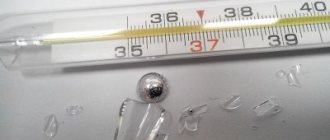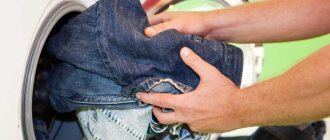Mercury is a silvery-white liquid metal whose vapors are extremely poisonous. Until the 70s, its compounds were actively used in medicine. Due to its high toxicity, it has practically ceased to be used in the production of medicines.
Mercury is still used to make medical thermometers. The reservoir with mercury is placed in a hermetically sealed tube narrowed on one side. Upon contact with the skin, it begins to heat up, and the mercury expands and rises. When the temperature reaches its maximum, the substance freezes at a certain point.
A thermometer is a fairly fragile device, so it can easily break if handled incorrectly. In this case, it is necessary to carry out demercurization - to collect mercury with its further neutralization and elimination of contamination.
Broken thermometer with mercury droplets
What danger does mercury pose to humans?
Mercury is an unsafe metal that can actively evaporate at temperatures from +18ºС, and freeze only at -38ºС. Accordingly, if the thermometer bulb is damaged, there is a high probability that the vapors of this chemical element will spread throughout the house. The child will be the first to suffer. So what is the danger?
Experts have proven that mercury vapor, when ingested, settles in the lungs, brain, and stomach. They begin their negative effects three to four hours after contact. As a result, a person’s nervous system is disrupted, noises appear in the head, and dizziness occurs.
The most important thing is to take precautions to remain invulnerable to the chemical component PHOTO: m.5-tv.ru
The gastrointestinal tract responds to poisoning with severe vomiting and general intoxication of the body. If mercury enters the respiratory system, pulmonary edema occurs and inflammation begins. The human body temperature rises to critical limits (40ºС).
The process of recycling mercury thermometers:
- hydrometallurgical (chemical) method of disposal.
Thermometers are subjected to wet crushing in a ball mill for three and a half hours at temperatures up to 60 degrees, with mercury being washed from the glass in a special solution. Then a liquid reagent of potassium iodide and sodium chloride is added there. After the process is completed, the reagent, which does not pose a danger to the environment and humans, is drained and transported for extraction by cementation with aluminum.
- thermal disposal method.
The thermometers are crushed, heated until the mercury turns into a vapor state, and the gas is sent to the condensate system and purified from mercury vapor to a sanitary standard.
First measures to eliminate household mercury pollution
The main condition for eliminating a hazardous metal spill indoors is considered to be efficiency. You cannot waste a minute after damaging the thermometer, preventing the harmful composition from spreading throughout the house.
- Be sure to remove all animals and children from the premises without wasting a minute.
- Ensure proper ventilation of the room by opening windows and doors so that there is a through flow of air.
- Quickly put on gloves and a respirator (a gauze bandage treated with soda solution will also work).
- To exclude possible contact with poison, you should put shoe covers or plastic bags on your feet, the latter will have to be firmly secured to the foot.
- We carefully inspect the room, after which we first collect all the glass fragments. Only then can you start cleaning.
A previously used gauze bandage will not protect against the penetration of dangerous vapors into the lungs PHOTO: more-vsego.net
If you are afraid for your health and do not want to do professional cleaning yourself, it is advisable to call the Ministry of Emergency Situations. They will perform demercurization, which involves cleaning the room from a liquid chemical element.
Where to throw away a broken thermometer
Close the glass container with water and a broken mercury thermometer tightly with a lid, place it out of the reach of children and take it to the recycling department as soon as possible.
Disposal of an entire thermometer
When the thermometer ceases to perform its function (if the device is damaged, has cracks or a displaced scale), it must be disposed of.
For medical institutions and other enterprises
To dispose of faulty mercury thermometers, they are placed in tightly closed labeled containers, which are stored in special rooms, then transferred to hazardous waste disposal organizations with the following documentation completed:
- technological log of medical waste (total weight of recycled thermometers, their quantity, date and time of removal, name of the organization that carries out transportation).
- documents confirming the removal and disposal of waste (they are issued by the company conducting the disposal).
For individuals
A broken or faulty mercury thermometer is subject to mandatory disposal by private individuals. Unfortunately, not everyone knows how to do this correctly and not all localities have organizations for recycling devices containing mercury.
In major cities
In large cities and metropolitan areas, a faulty thermometer or container of mercury can be disposed of in environmental containers or special terminals. Most often, the SES and Ministry of Emergency Situations services deal with the disposal of mercury-containing devices. In addition, there are private companies, environmental institutes, and demercurization centers where they accept faulty thermometers and collected mercury.
In the countryside
In cities with a population of less than 200 thousand people, there are usually no enterprises that accept and dispose of mercury thermometers. Residents of small towns and villages can contact the SES, the local administration, or go to the nearest regional center that has a collection point for mercury machines.
Rules for self-collection of mercury
Do not use a broom or vacuum cleaner to collect mercury droplets. This will give the metal an even greater opportunity to evaporate and create a high concentration of the chemical element in the air. Cleaning is performed as follows.
To get mercury out of the cracks, you can use a syringe, but then you need to place it along with all your things in a bag PHOTO: privet.club
Visual inspection
We carefully inspect the floor and surfaces that were in the zone of destruction of the mercury thermometer. If necessary, remove the baseboards and check the cracks if the floor is made of wood. If the balls end up on a rug, bedspread or other textile surfaces, they should be rolled up and placed in a sealed bag.
Before cleaning, you may even need to dismantle the floor covering PHOTO: pol-exp.com
Collection of mercury balls
Let's assume that the balls have rolled out on a smooth floor covering; under no circumstances should you press them or try to wipe them off. Take a sheet of clean white paper. Do not use pages from newspapers and magazines, as the metal is difficult to see on them. Carefully lift each ball and roll it into the middle of the sheet. We carefully collect everything, without crushing those already collected. Place the found particles into a jar of cold water and cover with a lid. Instead of a leaf, you can use adhesive tape and adhesive tape, which after collecting together with the balls we put into a container.
Adhesive tape should be used carefully, as the balls are very easy to crush PHOTO: vizhivanie.com
What does chemical treatment mean?
The use of chemicals is only justified if the balls have spread widely throughout the room, are not visible, or have been accidentally damaged. There are special kits and fillers for such purposes.
All chemical compositions for destroying mercury must be diluted in a plastic bucket PHOTO: dejstvuj.ru
Disinfection kit options
Demercurization packages are capable of destroying the dangerous active substance mercury in any room. Only a few formulations are considered the most popular. According to experts, these products effectively cope with the problem of pollution.
- Demercurization kit DEMERKIT SKM-10 eliminates large amounts of released chemicals. Mainly intended for the rapid destruction of vapors formed in the air of a room up to 10 m².
- Demercurization kit DEMERKIT SKM-50 (laboratory) is an excellent composition that allows you to quickly get rid of toxic metal on your own. The kit includes a respirator and an indicator of mercury in the air.
- Demercurization kit DEMERKIT SKM-20 (household). Immediately after contact with mercury, the drug prevents vapor from spreading to other rooms. Designed for reusable use.
The composition must be stored only in tightly closed packaging PHOTO: econ-hg.ru
Before using any of the chemicals to combat mercury leaks, you must carefully study the instructions that come with the kit and may be written on the packaging.
What available tools are suitable?
The most effective folk remedy that is prepared to destroy traces of mercury evaporation indoors is potassium permanganate and chlorine. After all the mercury has already been collected, it is necessary to destroy its remains on the floor. To do this, dilute potassium permanganate in an amount on the tip of a knife in two liters of water. Then pour liquid bleach, moisten a rag with this solution and walk thoroughly along the floor in those places where the metal balls were collected.
A sore throat is the first sign of chemical poisoning PHOTO: botanichka.ru
Water diluted with bleach does a good job. To do this, you will need a bucket of water (8-10 liters) and half a liter of liquid chlorine (white will do). Dip a cloth into the mixture and thoroughly wipe the infected areas. Ventilate the room and wash the floor as usual.
On a note! Before the procedure, to avoid chemical poisoning and also to protect the skin of your hands from drying out, be sure to wear a protective bandage on your face and rubber gloves on your hands.
You should not come close to mercury with bare parts of your body PHOTO: informator.news
Processing after
If the main work is completed and all the mercury is collected, this does not mean that you can relax:
- The cleaned carpet is treated with a manganese solution. It eliminates the volatile properties of vapors and slows down their action. If the coating is light, replace potassium permanganate with soda.
- Any bleaching agent is also suitable for treatment. Bleach is mixed with water in a ratio of one to five. Surfaces are treated with a damp sponge and left for half an hour. Then wash with plenty of water. The next day the procedure must be repeated.
- The room is regularly ventilated after the incident. If possible, it is better not to close the window at all for some period of time.
- The carpet needs to be beaten out in the fresh air - the sooner the better. During work, the respiratory system must be protected. It is advisable to go to non-residential premises.
- If mercury gets on clothes, it is disposed of without any regret (even if we are talking about the most favorite T-shirt).
- It is important to protect yourself as much as possible. After eliminating the incident, wash thoroughly in the shower, rinse your mouth and take a couple of tablets of activated carbon (sorbent). Now you need to drink more liquid (plain water or milk).
Important! A very popular question is how long does evaporation take. A ball of mercury with a diameter of 3 millimeters will take 3 years to completely disappear.
If you are interested in how to clean a white carpet, take a look here. This article will tell you how to remove cat and dog hair; this article will tell you how to get rid of various stains.
Consequence of demercurization: how to avoid poisoning
To avoid any health problems after treating a poisoned room, it is necessary to rinse the mucous membranes with a weak solution of potassium permanganate. You can also use regular Miramistin as an antiseptic. It is sold in any pharmacy.
Mercury can cause burns if taken in bare hands PHOTO: chemistry-chemists.com
It is also recommended to take a shower with antibacterial soap and wash your hair thoroughly. Remember to take the packages containing the hazardous substance outside to prevent re-exposure.
Final stage
It is important to understand that not only the jar of mercury is subject to disposal, but also the gloves, mask and bags (possibly shoes) in which the cleaning was carried out.
In addition, even if vapor poisoning is minor, a number of preventive actions need to be taken:
- Drink some kind of absorbent (activated carbon, Atoxil, etc.).
- Drink plenty of fluids, water and milk.
- After cleaning, rinse your mouth and throat with a weak solution of manganese.
Don't just throw it away, but recycle it
After collecting the mercury in a sealed container, it is not enough to throw it in the trash. The container may be damaged, after which the metal will erode out and cause many problems to other people. To prevent this from happening, you need to contact the Ministry of Emergency Situations, explaining the situation. Rescuers will definitely give the necessary recommendations.
Special eco-boxes can be used as a receiver. But they can only be used if the mercury balls are placed in a small container PHOTO: 56nv.ru
In almost every locality there are collection points for waste containing mercury. Go there and give away all things that came into contact with harmful metal.
It is better to choose a transparent jar for collecting toxic substances PHOTO: ladyspecial.ru
Avoid mistakes
There are a number of common mistakes when cleaning up mercury:
- Using a vacuum cleaner.
- Collect balls with a broom, stiff brush, or rag.
- Throwing mercury into the garbage chute, onto the street, or flushing it into the water supply system.
- It is very dangerous to leave items of clothing or linen at home that have been in contact with mercury.
If you break a mercury thermometer at home, do not panic. Follow the rules described and everything will be fine. If you are not sure of the correctness of your actions, it is better to immediately contact the Ministry of Emergency Situations.
Features of mercury collection on different surfaces
There are several ways to clean up mercury at home. The chemical can be spilled on any surface, therefore, if everything is clear with cleaning the floor, then we will look at the actions in the event that toxic balls get on furniture, carpet or metal panels, in this section.
Even the smallest balls must be collected PHOTO: topnews.ck.ua
Upholstered furniture and carpet (carpet)
If mercury particles get on upholstered furniture, you can use a syringe or a syringe with a thick spout. The metal must be sucked in so that the balls are not crushed, but smoothly move inward. They collect poison from the carpet in the same way. Then clean the infected area with a solution of potassium permanganate, and then re-treat it with any cleaning composition.
On a note! When using manganese, you risk damaging the furniture. If you overdo it with the concentration of the substance, it is possible to paint the upholstery a different color.
The poisoned part of the carpet can be cut out, of course, if this does not affect its appearance PHOTO: ru.wikihow.com
Long-pile carpet is more difficult to clean, so we carefully roll it from one side to the other so as not to lose the balls. We take it outside. We lay down the film and, after hanging the carpet, carefully knock out the toxic elements. We dispose of this chemical substance together with the package.
Do not use plastic pipettes to collect mercury substance PHOTO: ok.ru
Removing mercury from the table
The table, as a rule, also has a smooth surface. Therefore, cleaning will be similar to what was done on the floor.
- Prepare a jar of cold water.
- Take a soft brush and a paper adhesive plaster.
- Sweep the balls onto the adhesive strip.
- Dip the tape with the stuck mercury balls into cold water and cover with a lid.
Be sure to look at the cabinets and shelves that can be equipped with the table. If any of the boxes were open during the incident, then the likelihood that harmful substances got there is quite high.
All mercury thermometers must be stored in special cases for safety reasons PHOTO: otomkak.ru
What can't you do?
Unfortunately, not everyone is aware of the correct actions during demercurization (that is what this process is correctly called), so very serious mistakes are often made. If mercury gets on surfaces, it is prohibited:
- use a vacuum cleaner. This method is not suitable, since the air heated by the vacuum cleaner causes the metal to evaporate more actively, and also contributes to the dispersion of fine particles of mercury throughout the room. In addition, in the future, removing mercury residues from the bag or cyclone container of the vacuum cleaner will be extremely difficult;
- Dispose of the remaining thermometer as household waste or use a garbage disposal for these purposes. Mercury belongs to the class of highly hazardous substances, therefore its disposal as solid waste is unacceptable and leads to pollution of city landfills;
- throw the mercury thermometer or the contents of a broken flask into the toilet or flush it down the drain. In this case, hazardous substances penetrate into wastewater, polluting the environment, or accumulate in a septic tank;
- take a broken thermometer and its contents with bare hands, play with mercury, or allow children or pets to come into contact with the substance;
- use a broom or brush to collect. Bristles can break large balls into smaller ones, thereby complicating their elimination. Well, if there are cracks, holes or unevenness in the floor, the elimination process may become completely impossible or extremely difficult.
What is prohibited to do if the room is contaminated with mercury
Do not work with a mercury thermometer in a children's room PHOTO: otomkak.ru
Improper handling of a toxic substance often entails the most negative consequences. Therefore, it is not recommended to do the following:
- take a chemical element with bare hands;
- use a brush, vacuum cleaner and other rough cleaning products;
- pour boiling water or steam over the poisoned area;
- wash contaminated items in the washing machine;
- reuse items that have been in contact with toxic metal;
- throw mercury into the trash or drain.
An electronic thermometer is safe, but less accurate PHOTO: ecotestexpress.ru
Scientists believe that 2 g of mercury can poison up to 10 people PHOTO: lungwort51.rf
To prevent mercury from becoming a source of poisoning for your family members, you must take precautions. The main thing is to completely eliminate contact with the chemical element of all residents of the apartment or house.
Dear readers, if you have any questions about the material in today’s publication, be sure to ask them in the comments. Have you ever broken thermometers? What did you do in such a situation?
Video
We offer you to watch videos on the topic of the article:
She graduated from the author's physics and mathematics lyceum and art school. Received a higher education in economics with a major in innovative management. Freelancer. Married, actively travels. He is interested in Buddhist philosophy, enjoys transurfing and loves Mediterranean cuisine.
Found a mistake? Select the text with the mouse and click:
Stretch ceilings made of PVC film can withstand from 70 to 120 liters of water per 1 m2 of their area (depending on the size of the ceiling, the degree of its tension and the quality of the film). So you don’t have to worry about leaks from neighbors above.
Threads made of gold and silver, which were used to embroider clothes in the old days, are called gimp. To obtain them, the metal wire was pulled for a long time with pliers to the required fineness. This is where the expression “to drag out the rigmarole” came from - “to do long, monotonous work” or “to delay the completion of a task.”
If your favorite things show the first signs of gestation in the form of untidy pellets, you can get rid of them using a special machine - a shaver. It quickly and effectively shaves off clumps of fabric fibers and returns things to their proper appearance.
The easiest way to remove scale and carbon deposits from the soleplate of the iron is with table salt. Pour a thick layer of salt onto the paper, heat the iron to maximum and run the iron over the salt bed several times, applying light pressure.
The habit of using an automatic washing machine “sparingly” can lead to the appearance of an unpleasant odor in it. Washing at temperatures below 60℃ and short rinses allow fungi and bacteria from dirty clothes to remain on internal surfaces and actively multiply.
Before removing various stains from clothing, you need to find out how safe the selected solvent is for the fabric itself. It is applied in a small amount to an inconspicuous area of the item from the inside out for 5-10 minutes. If the material retains its structure and color, you can move on to stains.
Fresh lemon is not only suitable for tea: clean dirt from the surface of an acrylic bath by rubbing with half a cut citrus, or quickly wash the microwave by placing a container of water and lemon slices in it for 8-10 minutes at maximum power. The softened dirt can simply be wiped off with a sponge.
There are special traps to combat moths. The sticky layer with which they are covered contains female pheromones that attract males. By sticking to the trap, they are eliminated from the reproduction process, which leads to a decrease in the moth population.
The dishwasher cleans more than just plates and cups. You can load it with plastic toys, glass lamp shades and even dirty vegetables, such as potatoes, but only without using detergents.











